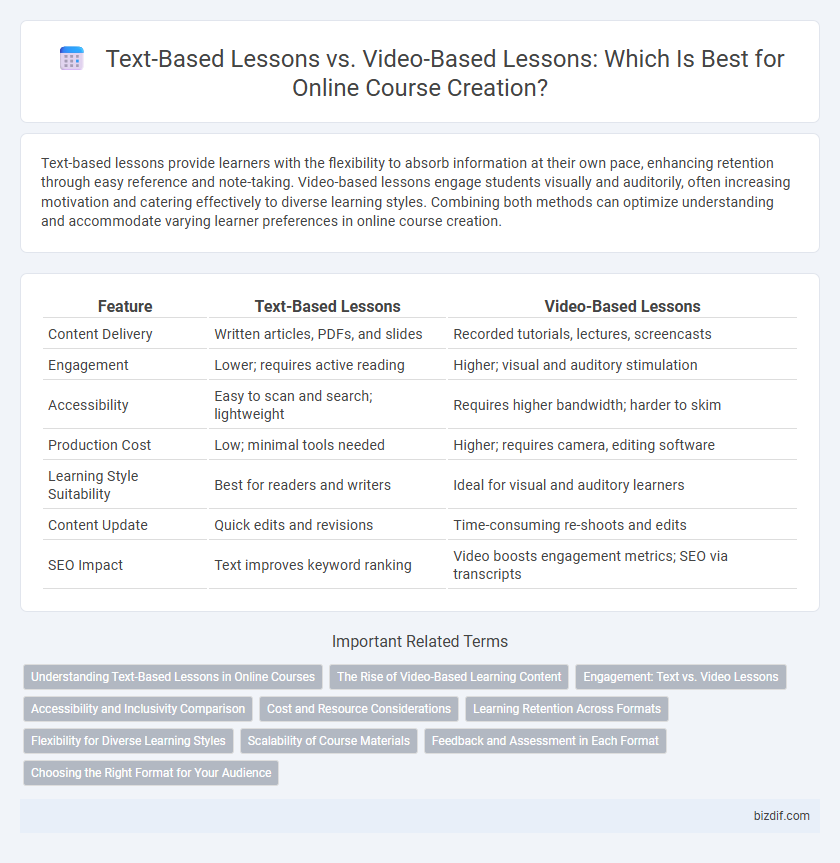Text-based lessons provide learners with the flexibility to absorb information at their own pace, enhancing retention through easy reference and note-taking. Video-based lessons engage students visually and auditorily, often increasing motivation and catering effectively to diverse learning styles. Combining both methods can optimize understanding and accommodate varying learner preferences in online course creation.
Table of Comparison
| Feature | Text-Based Lessons | Video-Based Lessons |
|---|---|---|
| Content Delivery | Written articles, PDFs, and slides | Recorded tutorials, lectures, screencasts |
| Engagement | Lower; requires active reading | Higher; visual and auditory stimulation |
| Accessibility | Easy to scan and search; lightweight | Requires higher bandwidth; harder to skim |
| Production Cost | Low; minimal tools needed | Higher; requires camera, editing software |
| Learning Style Suitability | Best for readers and writers | Ideal for visual and auditory learners |
| Content Update | Quick edits and revisions | Time-consuming re-shoots and edits |
| SEO Impact | Text improves keyword ranking | Video boosts engagement metrics; SEO via transcripts |
Understanding Text-Based Lessons in Online Courses
Text-based lessons in online courses enhance comprehension through clear, concise content that learners can review at their own pace, boosting retention and critical thinking. They enable easy navigation and quick reference, supporting learners who prefer reading over watching videos. Effective text-based lessons incorporate interactive elements like quizzes and summaries to reinforce understanding and engagement.
The Rise of Video-Based Learning Content
Video-based learning content has surged in popularity due to its engaging format, allowing learners to absorb information through visual and auditory cues, which enhances retention and comprehension. Platforms like YouTube and Vimeo have fueled this rise by providing accessible tools for creators to produce high-quality video lessons, making complex topics easier to understand. Studies indicate that video-based lessons increase learner motivation and completion rates compared to traditional text-based materials, driving a shift in online course design strategies.
Engagement: Text vs. Video Lessons
Video-based lessons generate higher engagement by combining visual, auditory, and kinesthetic elements that cater to diverse learning styles. Text-based lessons support in-depth comprehension and allow learners to progress at their own pace, enhancing retention through active reading. Integrating video's dynamic appeal with text's detailed explanations creates a balanced, immersive learning experience that maximizes user interaction.
Accessibility and Inclusivity Comparison
Text-based lessons offer greater accessibility for learners with hearing impairments and those who rely on screen readers, ensuring content is easily navigable and searchable. Video-based lessons provide visual and auditory engagement but may require captions, transcripts, and adaptable playback speeds to accommodate diverse learning needs. Combining both formats maximizes inclusivity by addressing varied preferences and accessibility requirements across different learner demographics.
Cost and Resource Considerations
Text-based lessons require lower production costs and minimal technical resources, making them ideal for budget-conscious course creators. Video-based lessons demand higher investments in equipment, editing software, and filming time but can enhance learner engagement and retention. Choosing between formats depends on balancing initial expenses with desired educational impact and available production capabilities.
Learning Retention Across Formats
Text-based lessons enhance learning retention by allowing learners to review material at their own pace and engage in active reading strategies, which reinforce comprehension. Video-based lessons increase retention through visual and auditory stimuli, supporting memory through multisensory engagement and storytelling techniques. Combining text and video formats optimizes retention by catering to diverse learning preferences and reinforcing key concepts through multiple channels.
Flexibility for Diverse Learning Styles
Text-based lessons offer flexibility for learners who prefer reading and self-paced study, allowing easy navigation and quick reference. Video-based lessons cater to visual and auditory learners through dynamic presentations, enhancing engagement and comprehension. Combining both formats maximizes accessibility and addresses diverse learning preferences effectively.
Scalability of Course Materials
Text-based lessons offer superior scalability in online course creation, as they can be easily updated, translated, and adapted for diverse learner needs without significant resource investment. Video-based lessons require more time and technical expertise to modify or localize, limiting rapid scalability. For large-scale course deployment, text-based content provides greater flexibility and cost-efficiency in updating and distributing materials.
Feedback and Assessment in Each Format
Text-based lessons allow for precise, easily scannable feedback through comments and quizzes, enabling learners to review and apply corrections instantly. Video-based lessons provide dynamic assessment opportunities via interactive elements like embedded quizzes and real-time instructor feedback, enhancing engagement and comprehension. Both formats support varied feedback styles, but video lessons often facilitate richer, more personalized assessments through visual and auditory cues.
Choosing the Right Format for Your Audience
Text-based lessons offer flexibility for learners who prefer reading at their own pace and benefit from easy referencing and quick scanning of information. Video-based lessons engage visual and auditory learners by providing dynamic content delivery, demonstrations, and enhanced emotional connection. Tailoring the format to your audience's learning preferences and accessibility needs ensures higher engagement and improved knowledge retention.
Text-based lessons vs Video-based lessons Infographic

 bizdif.com
bizdif.com